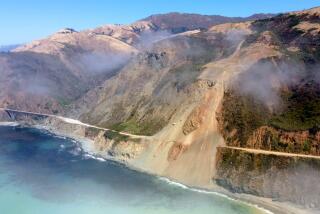Worst-Pace Scenario : Publicity ‘Blitz’ Led to Phantom Jams on Ventura Freeway
- Share via
Caltrans officials had been meeting for months in their field office’s wood-paneled conference room, devising ways to downplay the impact of the Ventura Freeway widening project on thousands of commuters. Two weeks ago, they shifted gears entirely.
Suddenly, they realized they couldn’t soft-pedal the effects of the 16-month, $18.3-million construction project any longer--not when it appeared that closing three out of four lanes until 11 a.m. on weekends in late June and July could result in massive traffic jams with backups 10 miles long.
That calamity was averted last weekend--and again on Saturday--through a public relations “blitz” that Caltrans officials launched earlier this month with some reluctance, they said. But any reservations officials may have had were cast aside in the scramble to quickly get the news out about the lane closures and their extraordinary potential impact.
“There was this little moment of silence when we first heard how bad it could be,” said George-Ann Rosenberg, a publicist hired by Caltrans for the project. “Here we had been spending months trying to reassure the public about the project, and now we were going to have to tell them it could have awful effects on their summer weekends.”
20% Reduction
Up until last weekend, Rosenberg said, lanes had been closed only during late-night hours, and traffic had barely been affected. Although officials had known of the impending daytime closures for months, they were not told of the possible impact until a June 7 meeting in Woodland Hills, when senior project engineer Dick Kermode advised them to try to reduce traffic by at least 20%.
The stategy appears to have worked well so far. During the lane closures, traffic has flowed smoothly on the westbound Ventura Freeway construction area between White Oak and Canoga avenues. And though the flow was slower than normal, it did not approach the conditions Caltrans officials had warned could occur if people did not stay off the freeway.
Rosenberg said the greatest risk in trying to dissuade motorists from using the freeway was that people--newscasters and drivers alike--would overreact. Market research surveys conducted before the project began March 8 pointed to that possibility with results showing that some motorists erroneously believed the freeway would be closed for five years, she said.
And some journalists, particularly television newscasters, can be masters of hyperbole, Rosenberg said, which only adds to the problem.
“If I hear the word ‘nightmare’ attached to the project one more time, as in ‘a nightmare for commuters,’ I’ll scream,” she said.
It was Robert C. Cashin, chief of public and governmental affairs for Caltrans in the Los Angeles area, who decided not to mince words in informing the public of the closures.
“I run on the philosophy of no surprises,” Cashin said. “To get Olympic-style cooperation, we had to tell the public what to expect.”
More than 100 news releases were mailed June 15 to area newspapers, radio and TV stations, and Caltrans staff members worked extra hours giving interviews. They also met with representatives of the Los Angeles Police Department, the California Highway Patrol and the city transportation department to map out where extra traffic control officers should be stationed and how to adjust traffic signals to allow longer green lights on Ventura Boulevard, one of the suggested alternate routes.
On June 17, the night before the first lane closure, more than 1,500 people called a free information telephone line set up by Caltrans to ask about the closures. The hot line has been in place since March, but Caltrans had never received so many calls on it before, Rosenberg said.
Ken Gallacher, a traffic reporter for radio stations KFI-AM and KOST-FM for years, said this was the most highly publicized phase of a freeway construction project he had ever seen. But he questioned the continued effectiveness of the campaign in the coming weeks.
“I think people are going to get tired of the darn thing and drive on the freeway anyway,” Gallacher said.
Officer Kenn Rosenberg, a Highway Patrol spokesman in charge of the freeway project, said officials are concerned that if the weather improves, the freeway will be flooded with beach-goers. Last weekend, and again on Saturday morning, area beaches were foggy, and skies were hazy.
But Cashin said he was confident that motorists will continue avoiding the Ventura Freeway before 11 a.m. for the next few weekends, excluding the Fourth of July, when all lanes will be open.
“Nobody wants to be stuck in traffic,” he said.
More to Read
Sign up for Essential California
The most important California stories and recommendations in your inbox every morning.
You may occasionally receive promotional content from the Los Angeles Times.













